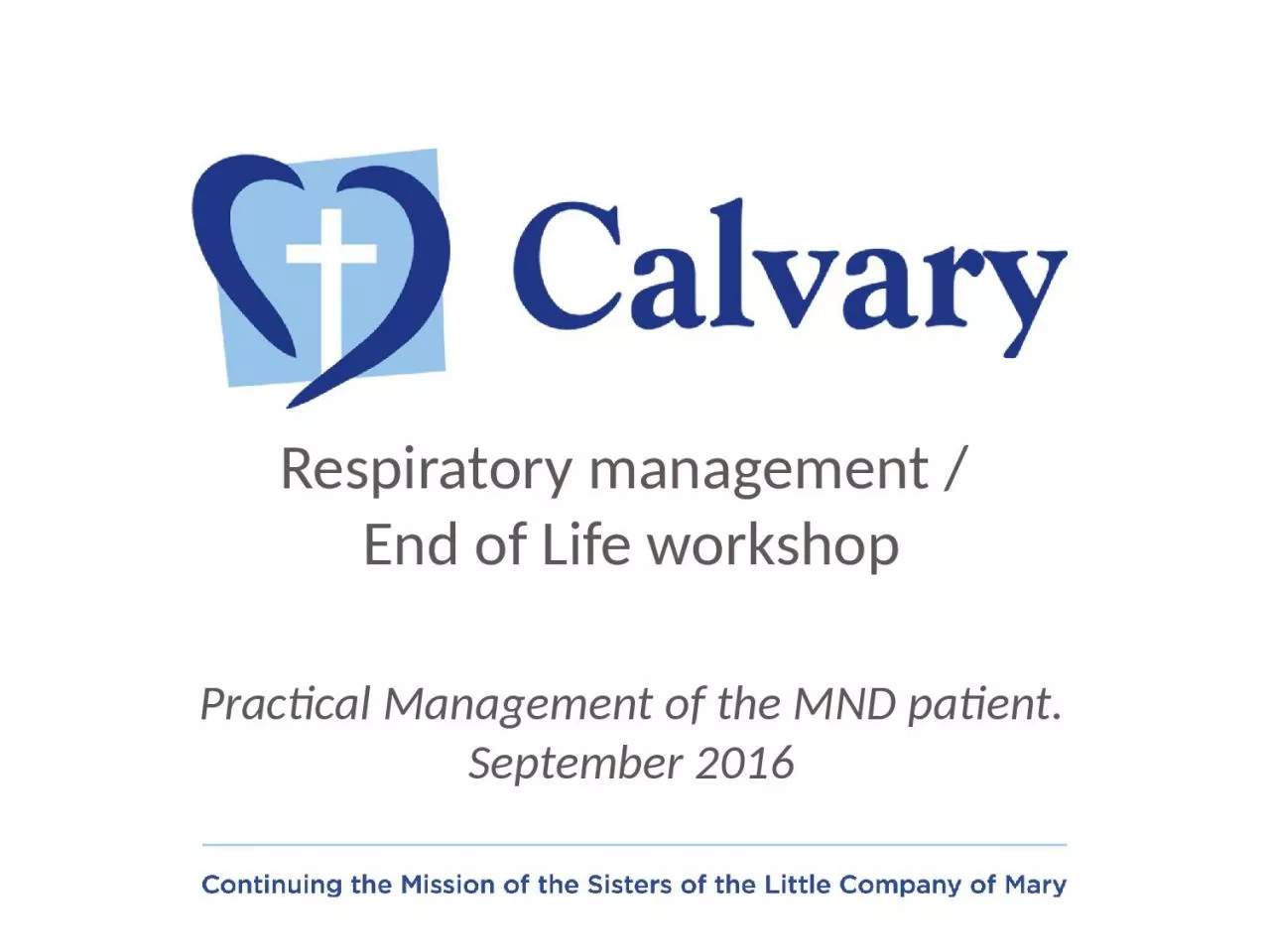

End of Life workshop Practical Management of the MND patient September 2016 Muscles of breathing Diaphragm Intercostal muscles Accessory muscles of breathing All these muscles gradually weaken in MND ID: 916201
Download Presentation The PPT/PDF document "Respiratory management /" is the property of its rightful owner. Permission is granted to download and print the materials on this web site for personal, non-commercial use only, and to display it on your personal computer provided you do not modify the materials and that you retain all copyright notices contained in the materials. By downloading content from our website, you accept the terms of this agreement.
Slide1
Respiratory management /
End of Life workshop
Practical Management of the MND patient.
September 2016
Slide2Muscles of breathing
Diaphragm
Intercostal muscles
Accessory muscles of breathing
All these muscles gradually weaken in MND
Slide3What makes an effective cough?
Effective cough needs:1. Big breath in (muscles of inspiration)
2. Closure of glottis (muscles of throat)
3. Strong, rapid expulsion of air (abdominals and internal intercostals)Purpose of cough
is to clear secretions from the airways.
Slide4How can we
improve
air entry?
Ventilation – invasive or non-invasive (NIVV):
Helps with gas exchangeReduces effort of breathing
Breath stacking using an air viva:
Enables a big breath to help clear secretionsMaintains flexibility of rib cage
Positioning well in bed or chair.
Diaphragmatic pacing
:
Stimulates
diaghragm
. Divided opinions on efficacy and safety.
Bagging circuit used to help air entry
Mask used with NIVV
Slide5How can
we improve cough?
Manual assisted cough
.Helps explosive breath out. Useful technique. Practice in pairs.
Cough assist machineMechanical assistance pushes breath in and sucks breath out.Not suitable for Bulbar patients as airways collapse with suction.
SuctioningOccasionally used for secretions that get caught in the throat.Vibrating Vest
Loosens secretions. Not available in Australia.
Slide6Music Therapy & End Of Life Care
What is the role of music therapy in end of life care?
Legacy
Comfort & Containment
Bereavement work (children)
Slide7Legacy
Work –
Prior to terminal phase
Song writing
Therapeutic process
Providing tangible ways in which memories and connections can be recorded and preserved for family, including children, partners and parents
.
For Meg working through the song writing process could provide therapeutic value to existential crisis and also is a practical avenue, by which she can feel that she is assisting her children after her death.
TIMING!
Slide8Comfort & Containment
- Terminal Phase
In the moment
“Holding the space” for families and patient and can provide a meaningful activity which allows emotions and sentiments to be released.
Can relieve the sense of “waiting” for the inevitable
Can facilitate positive reflect on the life and memories of the patient.
Can also be a positive memory of the terminal phase for family.
Slide9Bereavement
– After death (with children)
Children of all ages grieve very differently, they might be unable or unwilling to openly discuss their grief or even be aware that they are grieving.
Music therapy and other arts based therapies provide an opportunity for children to explore their grief and understanding of death.
Music and art based activities often illicit grief reactions that wouldn’t necessarily be apparent through conversation based therapy.
Very often these activities can also help provide explanations of death if children are struggling to understand it as a concept.
Meg’s children are only three years apart but their comprehension, reaction too and expression of grief might be quite distinct when considering developmental and other differences.
Slide10Non Invasive Ventilation (NIV)
Regular lung function testing
Sleep study at Austin Health
Victorian Respiratory Support Service – VRSS Outreach
If tolerated NIV, good symptom control
Life prolonging
Risk of ventilator dependency
Slide11Jan 2016 – 3 yrs 8mths
Secretion problems worse
-
Probanthine
tablets
- Saline nebuliser - Suction* Changed to
Glycopyrrolate tabltes
( special access)
Slide12March 2016 – 3 yrs 10mths
Decides against elective
tracheostomy
Using NIV @ 10/24 hours
Agrees to community Palliative care referral
Considering IDC
Slide13Easter Weekend
More dyspnoeic over 24-48 hours
Requiring constant use of NIV and regular morphine mixture
Anxious, secretions worse
Starts antibiotics via PEG
Decide not to call ambulance
Husband emails specialist
Slide14I’m back at work on Tuesday....
Phone call
- Feels a bit better, no fever
- Chest pain - Still using NIV most of the time
- Not keen to go hospital - Accepting of Pall care support at home
Slide15Liaised with
resp
physician / GP
Agreed empirical treatment for PE
Domicillary review by Pall care registrar / consultant
- stay at home - Syringe driver - IDC
Slide16Currently......
At home with family, regular visits from CPCS
Few hours off ventilator each day with children
S/D – morphine 10mg
midaz 10mg
glycopyrrolate 0.8mg
Attention to pressure care – allied health input Regular consultant input via
tele
-health